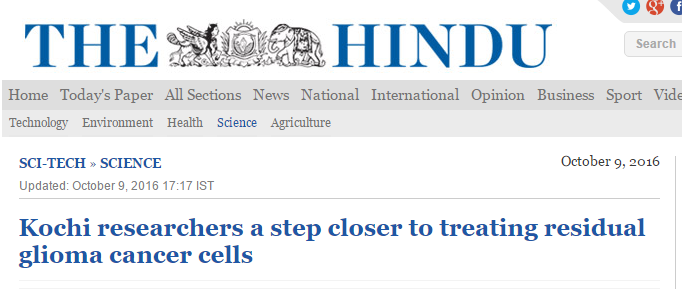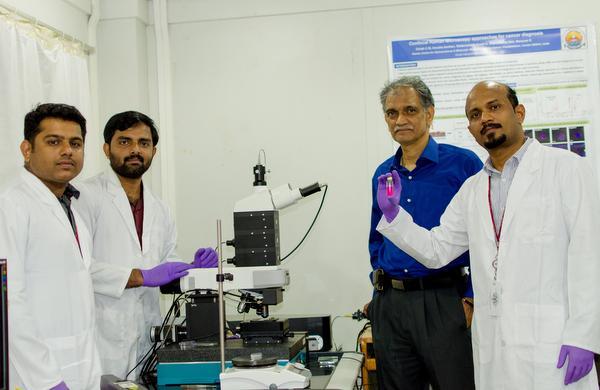The prolonged period of stability of the drug provides a longer window for therapy.
Scientists at the Amrita Centre for Nanosciences and Molecular Medicine at Amrita University, Kochi, have come a step closer to using photodynamic therapy for treating residual cancer cells of a high-grade brain tumour (glioblastoma). Photodynamic therapy uses a photosensitive drug that becomes active under the action of light and converts molecular oxygen into reactive oxygen species that kill cancer cells.
While the photosensitive drug injected into the body intravenously is not cancer-cell specific and is less efficient in absorbing light to generate reactive oxygen species, scientists at the Amrita Institute have turned to nanotechnology and used light in the near-infrared region to achieve better results. Light in the near-infrared region can penetrate to about 0.8 cm into body tissues.
“The drug encapsulated in a nanoparticle has peptides functionalised on its surface and is selectively absorbed only by cancer cells. The nanoparticles containing the drug have better ability to kill cancer cells as they absorb three times more light in the near IR region than the free drug,” says Dr. Manzoor Koyakutty from the Amrita Centre for Nanosciences and Molecular Medicine. “We have incorporated a photosensitiser into the nanoparticle to enhance the light absorption capacity.” Dr. Koyakutty had carried out studies on mice while he was in Erasmus University Rotterdam, the Netherlands.
A unique chemical bonding used for anchoring the photosensitiser to the nanoparticle increases the stability of the drug by as much as nine times, says Dr. Koyakutty. The prolonged period of stability of the drug provides a longer window for therapy; light in the near-infrared range can now be given in fractions to activate the drug at regular intervals.
“Even if the tumour mass is removed from the brain, some residual cancer cells will be present near the tumour site. We can’t remove healthy brain tissue that contains some cancer cells. So once you remove the tumour mass we can apply the nanoparticles containing the drug at the site where the tumour was present and use near-IR [light] to kill cancer cells in the neighbouring areas,” says Dr. Shantikumar Nair, Director of the Centre.
“Recurrence is very high in the case of glioma. Patients don’t have a cure if it recurs. So if recurrence can be prevented patients can have substantial additional life,” says Dr. Nair.
“Photodynamic therapy is a well known treatment option but can be used only when cancers are near the skin as light cannot penetrate deep. So it has not become a popular treatment option but has potential,” says Dr. Rajiv Sarin, Professor, Radiation Oncology and in-charge of Cancer Genetics Unit at Tata Memorial Hospital, Mumbai. “Getting clinical benefits in patients with cancer is more challenging as cancer is seldom near the surface.”
The scientists are planning to undertake studies on mice and then larger animals.

